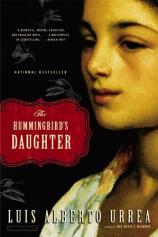Reading Group Guide
Discussion Questions
The Hummingbird's Daughter

1. Many readers and reviewers have compared The Hummingbird’s Daughter to the work of Gabriel García Márquez. How apt do you consider this comparison? Is The Hummingbird’s Daughter a work of magical realism? Why or why not?
2. One reviewer noted that The Hummingbird’s Daughter employs the techniques of “Catholic hagiography, Western fairy tale, Indian legend, and everyday family folklore.” Do you agree? Are elements of each of these literary traditions present in this book? Give examples to support your answer.
3. The Hummingbird’s Daughter is a wildly romantic work of fiction, but it is, in fact, grounded in historical truth. Luis Alberto Urrea conducted two decades of research, and to this day La Santa de Cabora is revered in some parts of northern Mexico. How does the author balance grim history with sweeping fiction?
4. Tomás Urrea likes to think of himself as a man of reason in a world filled with superstition. Indeed, he feels scorn for those who “saw the faces of Jesus Christ and the Virgin of Guadalupe in burned tortillas.” Yet he has trouble explaining Teresita’s resurrection. Have you ever had trouble finding a logical explanation for a strange occurrence?
5. In contrast to Tomás, Teresita believes that the “world of reason must be a lonely place.” What does she mean? Do you agree with her?
6. Despite his position as a powerful Patrón and his comfortable life on his ranch, Tomás can’t help feeling that his existence is a bit monotonous. Urrea writes, “Perhaps, deep in his heart, Tomás wanted no one to be wild if he himself could not run free.” How does the dichotomy between his quotidian routine and Teresita’s wildness inform their relationship?
7. Teresita’s healing powers are obviously a tremendous gift. But at the same time, they bring a lot of chaos into her life: pilgrims hound her, and Porfirio Díaz dubs her the “most dangerous girl in Mexico.” In what sense might Teresita be considered the Joan of Arc of Mexico?
8. Huila seems to think that all men are silly and that women will someday rule the world. And many of the novel’s strongest and most interesting characters are female. How are women presented in The Hummingbird’s Daughter? Does the novel have feminist undercurrents?
9. There are many journeys depicted in this novel. In what ways do these journeys mirror the modern immigrant experience?
10. Luis Alberto Urrea first heard the stories of his great aunt Teresita at family gatherings. Do you have any family members or relatives who have lived remarkable lives? What are their stories?
The Hummingbird's Daughter
- Publication Date: April 3, 2006
- Paperback: 499 pages
- Publisher: Back Bay Books
- ISBN-10: 0316154520
- ISBN-13: 9780316154529








